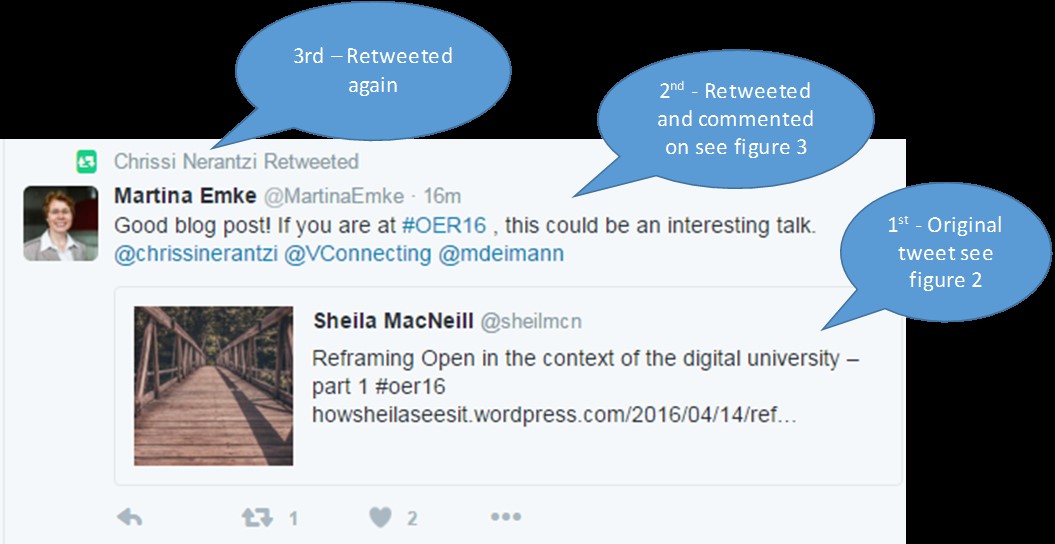Anatomy of a tweet – Introduction to twitter part 2
This post continues from the “Anatomy of a tweet part 1” posted on 6th May 2016 in which the component parts of a tweet were identified and explained. This post continues and looks at a more complex example shown in Figure1.

Figure 1

Figure 2 Original tweet by Sheila MacNeill
Sheila has tweeted an image and a web link to her blog post. Twitter automatically reduces the length of the web link so that the link appears in the tweet but ends with … but the link still works. She also included the hashtag #oer16.
In Figure 3 we see that Martina Emke has chosen to retweet Sheila’s tweet but also add her own comments. In this case twitter shrinks the layout of original tweet and places it below the new tweet.

Figure 3 Retweet with comments by Martina Emke
Martina includes the names of three twitter users @chrissinerantzi, @VConnecting and @mdeimann (remember all twitter usernames begin with @). She could have privately sent the tweet to them but as her tweet could be useful to all her followers she has sent it publically.
Finally Chris Nerantzi chose to retweet Martina’s tweet to all her followers (which include me) and thus the tweet appears in my twitter feed.
Why is this useful for me?
Hashtags are very useful as a tool for academics and researchers; this example was produced on the day of the OER16: Open Culture conference in Edinburgh run by ALT the Association of Learning Technologists. The hashtag for the conference was #OER16 (OER are Open Education Resources – the movement to publish and share openly). Some of the people I follow were at the conference which meant if they post I will see their posts in my twitter feed but if I use the hashtag to search I will see all the posts from anyone who uses the hashtag. Even if I didn’t have a twitter account I can still follow the “backchannel” from the conference and be alerted to additional resources being referred to by those helpful people sending tweets about the events at the conference.
There are a number of live streamed sessions at this conference which means I can not only view some of the sessions I can also interact with the conversations that take place via Twitter during and following the sessions. In this example you can see that twitter is a very powerful tool for academics/researchers.
In the previous “anatomy of a tweet part 1” the example chosen shows twitter is also a great tool for providing some light entertainment. Twitter is also a good communication tool, for example if you follow LJMU IT services, @LJMU_ITS, they let everyone know that the email problems encountered here at LJMU a few weeks ago were fixed. (Figure 4)

Figure 4
Things to try
1. Even if you don’t have a twitter account next time you see the details of a conference that includes the conference hashtag, just before or during the conference go to http://twitter.com and then type the hashtag in the search box and investigate the conference from your desk (or phone, tablet etc.)
More ideas on using twitter in the classroom/university
2. For more inspiration go to the web site 60 Inspiring Examples of Twitter in the Classroom Although primarily directed at school teachers it is clear from this article that there are a huge range of applications of twitter for a university tutor or researcher. Figure 5 shows my tweet linking to this article.

Figure 5
Twitter in the curriculum
3. Read this article Introducing Twitter as an assessed component of the undergraduate nursing curriculum: case study. Published in February 2016. Link to article
4. If you really want to, you can follow or search for celebrities or others that post what they had for breakfast (Figure 6) but that is up to you. Twitter is what you make of it.

Figure 6 #whatihadforbreakfast
